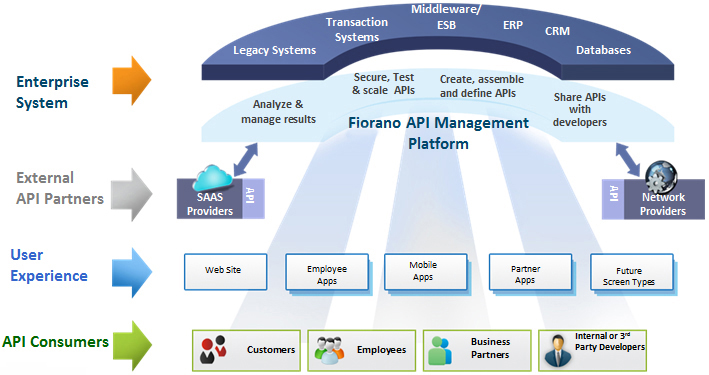Fiorano API Management
 Exposing interfaces to unique corporate data creates value that many companies have difficulty unlocking on their own. By exposing internal enterprise data and application functionality to external applications on mobile devices, consoles and affiliate Web sites, an organization can transform its business into an extensible platform. Enterprises require ways to publish APIs to external developers, to interact with customers over new mobility and social channels, innovative and evolve ways to reach new customers through partner and third party applications and exploit the exponential explosion of client end-points to drive end-user business, among others.
Exposing interfaces to unique corporate data creates value that many companies have difficulty unlocking on their own. By exposing internal enterprise data and application functionality to external applications on mobile devices, consoles and affiliate Web sites, an organization can transform its business into an extensible platform. Enterprises require ways to publish APIs to external developers, to interact with customers over new mobility and social channels, innovative and evolve ways to reach new customers through partner and third party applications and exploit the exponential explosion of client end-points to drive end-user business, among others.
Integration approach to API Management: Fiorano API Management is particularly well-suited for enterprises that need deep integration capabilities to build APIs on top of existing applications. The system offers a range of capabilities, including protocol transformation, mobile backend-as-a-service (MBaaS), standards-based access management, version management, API rate limiting, and metering (analytics). Backend and third-party web services can be transformed into easily consumable APIs, governed by self-service policies.
| Document Download | |
| |
|
- This is the central server which acts as the repository for the API Projects created by users and deploys them to API Gateway Servers.
- Hosts the API dashboard
- Incorporates an Analytics engine and performs various aggregation/ingestion functions.
- Manages Role Based Access Control
API Gateway Server
- Acts as a reverse proxy server for the backend REST/SOAP based web services that are to be exposed as APIs
- Receives client requests and performs Caching, Traffic Control, Quota Management, Authentication and Authorization before letting the request pass to a back end server.
- Provides load balancing capabilities in case the target service is hosted on multiple servers.
API Dashboard
The dashboard, hosted in the API Management server, provides interfaces to
- Create API projects with zero coding
- Define various API products, Developers and Subscriptions
- Analyze API trends, investigate spikes, define various roles, environments, partners and more.
The developer portal allows enterprises to publish and socialize their APIs. Support is included for
- Self signup of developers, allowing automatic subscription to public APIs
- Viewing API documentation related to various public and protected APIs.
Types of API Exposures
- APIs open to all developers
- Apps typically targeted towards consumers outside the enterprise
- Goals : engaging customers through external developers
- APIs open to select business partners only
- Apps targeted towards both consumers and business users
- Goals : specific to the business of the enterprise
- APIs exposed only to developers within the enterprise
- Apps targeted towards employees and/or enterprise systems
- Goals: driving employee productivity and internal system efficiencies

Fiorano API Management Key Capabilities
- Based on Fiorano market leading ESB and SOA platform
- Download and install in 30 mins and begin deploying your APIs
- Create and deploy new APIs in minutes
- Easily create portals to socialize your APIs
- Visible ROI in days, not month
- Pinpoint key market fluctuations and correlations related to your business
- Sophisticated inspection and debugging tools to identify bottlenecks and reduce development/deployment times
- API updates with minimal interruption
- Integrated debug/test/rollout to rapidly fix production issues
- Point-and-click snapshot restoration to previous versions

